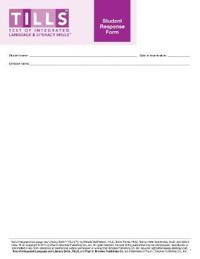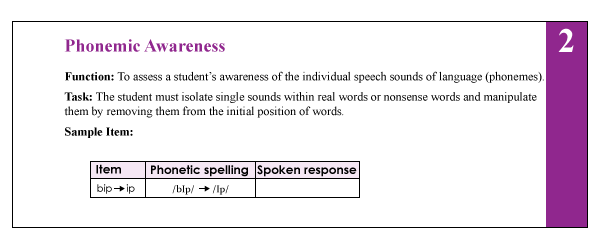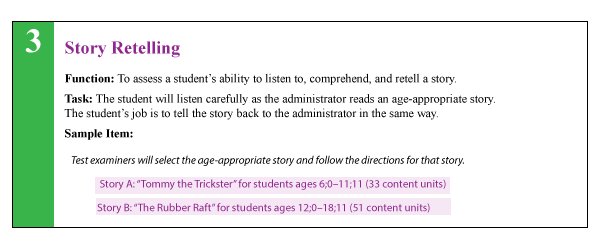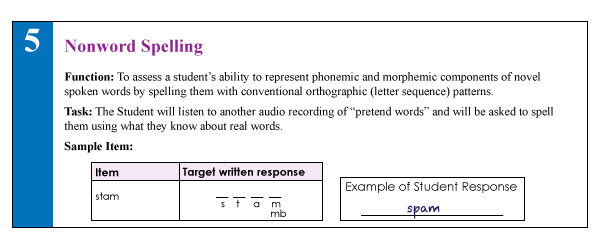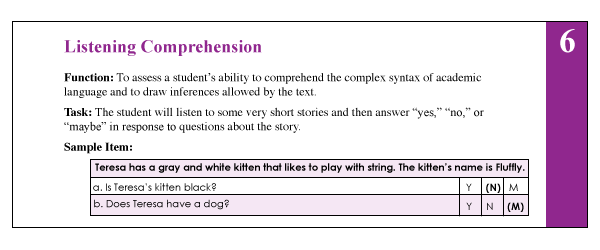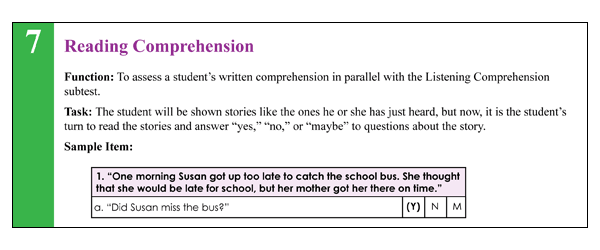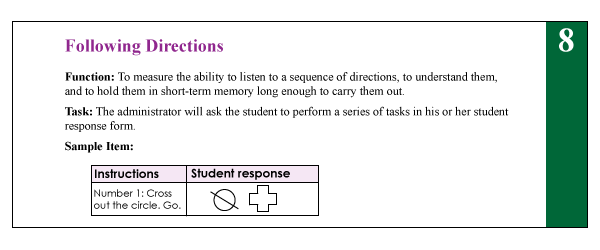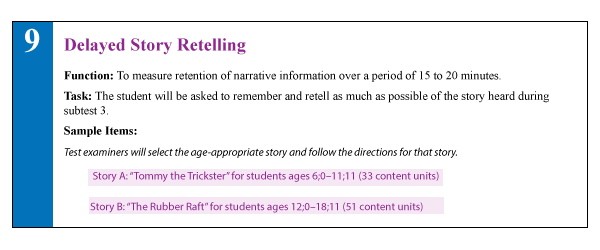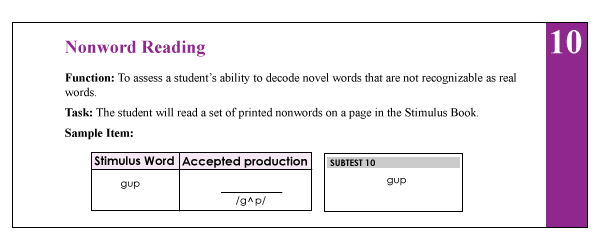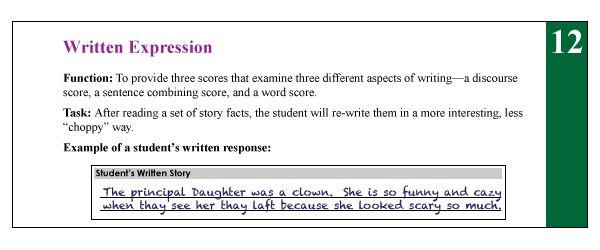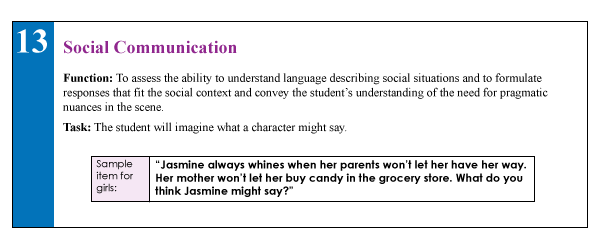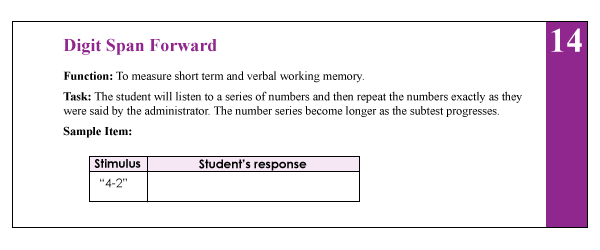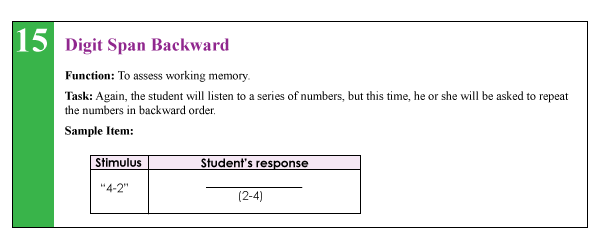 Lately, I’ve been seeing more and more posts on social media asking for testing suggestions for students who exhibit subtle language-based difficulties. Many of these children are typically referred for initial assessments or reassessments as part of advocate/attorney involved cases, while others are being assessed due to the parental insistence that something “is not quite right” with their language and literacy abilities, even in the presence of “good grades.” Continue reading Comprehensive Assessment of Elementary Aged Children with Subtle Language and Literacy Deficits
Lately, I’ve been seeing more and more posts on social media asking for testing suggestions for students who exhibit subtle language-based difficulties. Many of these children are typically referred for initial assessments or reassessments as part of advocate/attorney involved cases, while others are being assessed due to the parental insistence that something “is not quite right” with their language and literacy abilities, even in the presence of “good grades.” Continue reading Comprehensive Assessment of Elementary Aged Children with Subtle Language and Literacy Deficits
Category: Metalinguistics
What are They Trying To Say? Interpreting Music Lyrics for Figurative Language Acquisition Purposes
 In my last post, I described how I use obscurely worded newspaper headlines to improve my students’ interpretation of ambiguous and figurative language. Today, I wanted to further delve into this topic by describing the utility of interpreting music lyrics for language therapy purposes. I really like using music lyrics for language treatment purposes. Not only do my students and I get to listen to really cool music, but we also get an opportunity to define a variety of literary devices (e.g., hyperboles, similes, metaphors, etc.) as well as identify them and interpret their meaning in music lyrics. Continue reading What are They Trying To Say? Interpreting Music Lyrics for Figurative Language Acquisition Purposes
In my last post, I described how I use obscurely worded newspaper headlines to improve my students’ interpretation of ambiguous and figurative language. Today, I wanted to further delve into this topic by describing the utility of interpreting music lyrics for language therapy purposes. I really like using music lyrics for language treatment purposes. Not only do my students and I get to listen to really cool music, but we also get an opportunity to define a variety of literary devices (e.g., hyperboles, similes, metaphors, etc.) as well as identify them and interpret their meaning in music lyrics. Continue reading What are They Trying To Say? Interpreting Music Lyrics for Figurative Language Acquisition Purposes
Have I Got This Right? Developing Self-Questioning to Improve Metacognitive and Metalinguistic Skills
 Many of my students with Developmental Language Disorders (DLD) lack insight and have poorly developed metalinguistic (the ability to think about and discuss language) and metacognitive (think about and reflect upon own thinking) skills. This, of course, creates a significant challenge for them in both social and academic settings. Not only do they have a poorly developed inner dialogue for critical thinking purposes but they also because they present with significant self-monitoring and self-correcting challenges during speaking and reading tasks. Continue reading Have I Got This Right? Developing Self-Questioning to Improve Metacognitive and Metalinguistic Skills
Many of my students with Developmental Language Disorders (DLD) lack insight and have poorly developed metalinguistic (the ability to think about and discuss language) and metacognitive (think about and reflect upon own thinking) skills. This, of course, creates a significant challenge for them in both social and academic settings. Not only do they have a poorly developed inner dialogue for critical thinking purposes but they also because they present with significant self-monitoring and self-correcting challenges during speaking and reading tasks. Continue reading Have I Got This Right? Developing Self-Questioning to Improve Metacognitive and Metalinguistic Skills
Making Our Interventions Count or What’s Research Got To Do With It?
 Two years ago I wrote a blog post entitled: “What’s Memes Got To Do With It?” which summarized key points of Dr. Alan G. Kamhi’s 2004 article: “A Meme’s Eye View of Speech-Language Pathology“. It delved into answering the following question: “Why do some terms, labels, ideas, and constructs [in our field] prevail whereas others fail to gain acceptance?”.
Two years ago I wrote a blog post entitled: “What’s Memes Got To Do With It?” which summarized key points of Dr. Alan G. Kamhi’s 2004 article: “A Meme’s Eye View of Speech-Language Pathology“. It delved into answering the following question: “Why do some terms, labels, ideas, and constructs [in our field] prevail whereas others fail to gain acceptance?”.
Today I would like to reference another article by Dr. Kamhi written in 2014, entitled “Improving Clinical Practices for Children With Language and Learning Disorders“.
This article was written to address the gaps between research and clinical practice with respect to the implementation of EBP for intervention purposes.
Dr. Kamhi begins the article by posing 10 True or False questions for his readers:
- Learning is easier than generalization.
- Instruction that is constant and predictable is more effective than instruction that varies the conditions of learning and practice.
- Focused stimulation (massed practice) is a more effective teaching strategy than varied stimulation (distributed practice).
- The more feedback, the better.
- Repeated reading of passages is the best way to learn text information.
- More therapy is always better.
- The most effective language and literacy interventions target processing limitations rather than knowledge deficits.
- Telegraphic utterances (e.g., push ball, mommy sock) should not be provided as input for children with limited language.
- Appropriate language goals include increasing levels of mean length of utterance (MLU) and targeting Brown’s (1973) 14 grammatical morphemes.
- Sequencing is an important skill for narrative competence.
Guess what? Only statement 8 of the above quiz is True! Every other statement from the above is FALSE!
Now, let’s talk about why that is!
 First up is the concept of learning vs. generalization. Here Dr. Kamhi discusses that some clinicians still possess an “outdated behavioral view of learning” in our field, which is not theoretically and clinically useful. He explains that when we are talking about generalization – what children truly have a difficulty with is “transferring narrow limited rules to new situations“. “Children with language and learning problems will have difficulty acquiring broad-based rules and modifying these rules once acquired, and they also will be more vulnerable to performance demands on speech production and comprehension (Kamhi, 1988)” (93). After all, it is not “reasonable to expect children to use language targets consistently after a brief period of intervention” and while we hope that “language intervention [is] designed to lead children with language disorders to acquire broad-based language rules” it is a hugely difficult task to undertake and execute.
First up is the concept of learning vs. generalization. Here Dr. Kamhi discusses that some clinicians still possess an “outdated behavioral view of learning” in our field, which is not theoretically and clinically useful. He explains that when we are talking about generalization – what children truly have a difficulty with is “transferring narrow limited rules to new situations“. “Children with language and learning problems will have difficulty acquiring broad-based rules and modifying these rules once acquired, and they also will be more vulnerable to performance demands on speech production and comprehension (Kamhi, 1988)” (93). After all, it is not “reasonable to expect children to use language targets consistently after a brief period of intervention” and while we hope that “language intervention [is] designed to lead children with language disorders to acquire broad-based language rules” it is a hugely difficult task to undertake and execute.
Next, Dr. Kamhi addresses the issue of instructional factors, specifically the importance of “varying conditions of instruction and practice“. Here, he addresses the fact that while contextualized instruction is highly beneficial to learners unless we inject variability and modify various aspects of instruction including context, composition, duration, etc., we ran the risk of limiting our students’ long-term outcomes.
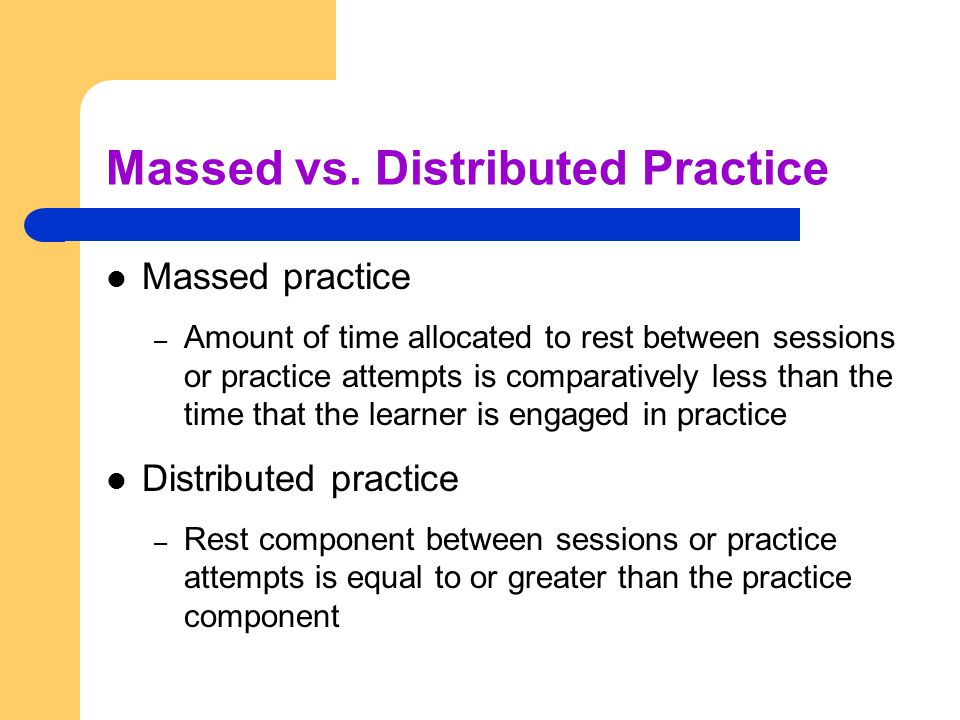 After that, Dr. Kamhi addresses the concept of distributed practice (spacing of intervention) and how important it is for teaching children with language disorders. He points out that a number of recent studies have found that “spacing and distribution of teaching episodes have more of an impact on treatment outcomes than treatment intensity” (94).
After that, Dr. Kamhi addresses the concept of distributed practice (spacing of intervention) and how important it is for teaching children with language disorders. He points out that a number of recent studies have found that “spacing and distribution of teaching episodes have more of an impact on treatment outcomes than treatment intensity” (94).
He also advocates reducing evaluative feedback to learners to “enhance long-term retention and generalization of motor skills“. While he cites research from studies pertaining to speech production, he adds that language learning could also benefit from this practice as it would reduce conversational disruptions and tunning out on the part of the student.
From there he addresses the limitations of repetition for specific tasks (e.g., text rereading). He emphasizes how important it is for students to recall and retrieve text rather than repeatedly reread it (even without correction), as the latter results in a lack of comprehension/retention of read information.
After that, he discusses treatment intensity. Here he emphasizes the fact that higher dose of instruction will not necessarily result in better therapy outcomes due to the research on the effects of “learning plateaus and threshold effects in language and literacy” (95). We have seen research on this with respect to joint book reading, vocabulary words exposure, etc. As such, at a certain point in time increased intensity may actually result in decreased treatment benefits.
 His next point against processing interventions is very near and dear to my heart. Those of you familiar with my blog know that I have devoted a substantial number of posts pertaining to the lack of validity of CAPD diagnosis (as a standalone entity) and urged clinicians to provide language based vs. specific auditory interventions which lack treatment utility. Here, Dr. Kamhi makes a great point that: “Interventions that target processing skills are particularly appealing because they offer the promise of improving language and learning deficits without having to directly target the specific knowledge and skills required to be a proficient speaker, listener, reader, and writer.” (95) The problem is that we have numerous studies on the topic of improvement of isolated skills (e.g., auditory skills, working memory, slow processing, etc.) which clearly indicate lack of effectiveness of these interventions. As such, “practitioners should be highly skeptical of interventions that promise quick fixes for language and learning disabilities” (96).
His next point against processing interventions is very near and dear to my heart. Those of you familiar with my blog know that I have devoted a substantial number of posts pertaining to the lack of validity of CAPD diagnosis (as a standalone entity) and urged clinicians to provide language based vs. specific auditory interventions which lack treatment utility. Here, Dr. Kamhi makes a great point that: “Interventions that target processing skills are particularly appealing because they offer the promise of improving language and learning deficits without having to directly target the specific knowledge and skills required to be a proficient speaker, listener, reader, and writer.” (95) The problem is that we have numerous studies on the topic of improvement of isolated skills (e.g., auditory skills, working memory, slow processing, etc.) which clearly indicate lack of effectiveness of these interventions. As such, “practitioners should be highly skeptical of interventions that promise quick fixes for language and learning disabilities” (96).
Now let us move on to language and particularly the models we provide to our clients to encourage greater verbal output. Research indicates that when clinicians are attempting to expand children’s utterances, they need to provide well-formed language models. Studies show that children select strong input when its surrounded by weaker input (the surrounding weaker syllables make stronger syllables stand out). As such, clinicians should expand upon/comment on what clients are saying with grammatically complete models vs. telegraphic productions.
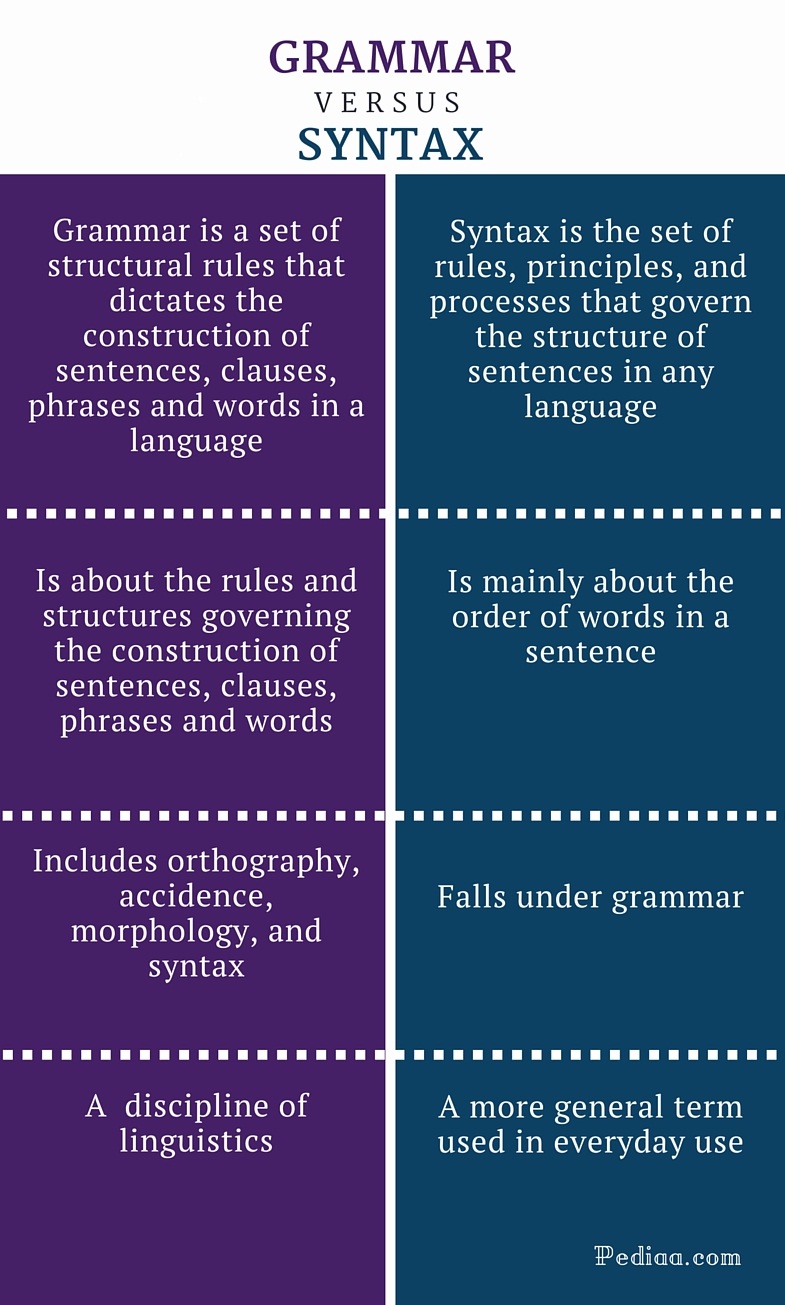 From there lets us take a look at Dr. Kamhi’s recommendations for grammar and syntax. Grammatical development goes much further than addressing Brown’s morphemes in therapy and calling it a day. As such, it is important to understand that children with developmental language disorders (DLD) (#DevLang) do not have difficulty acquiring all morphemes. Rather studies have shown that they have difficulty learning grammatical morphemes that reflect tense and agreement (e.g., third-person singular, past tense, auxiliaries, copulas, etc.). As such, use of measures developed by Hadley & Holt, 2006; Hadley & Short, 2005 (e.g., Tense Marker Total & Productivity Score) can yield helpful information regarding which grammatical structures to target in therapy.
From there lets us take a look at Dr. Kamhi’s recommendations for grammar and syntax. Grammatical development goes much further than addressing Brown’s morphemes in therapy and calling it a day. As such, it is important to understand that children with developmental language disorders (DLD) (#DevLang) do not have difficulty acquiring all morphemes. Rather studies have shown that they have difficulty learning grammatical morphemes that reflect tense and agreement (e.g., third-person singular, past tense, auxiliaries, copulas, etc.). As such, use of measures developed by Hadley & Holt, 2006; Hadley & Short, 2005 (e.g., Tense Marker Total & Productivity Score) can yield helpful information regarding which grammatical structures to target in therapy.
With respect to syntax, Dr. Kamhi notes that many clinicians erroneously believe that complex syntax should be targeted when children are much older. The Common Core State Standards do not help this cause further, since according to the CCSS complex syntax should be targeted 2-3 grades, which is far too late. Typically developing children begin developing complex syntax around 2 years of age and begin readily producing it around 3 years of age. As such, clinicians should begin targeting complex syntax in preschool years and not wait until the children have mastered all morphemes and clauses (97)
Finally, Dr. Kamhi wraps up his article by offering suggestions regarding prioritizing intervention goals. Here, he explains that goal prioritization is affected by
- clinician experience and competencies
- the degree of collaboration with other professionals
- type of service delivery model
- client/student factors
He provides a hypothetical case scenario in which the teaching responsibilities are divvied up between three professionals, with SLP in charge of targeting narrative discourse. Here, he explains that targeting narratives does not involve targeting sequencing abilities. “The ability to understand and recall events in a story or script depends on conceptual understanding of the topic and attentional/memory abilities, not sequencing ability.” He emphasizes that sequencing is not a distinct cognitive process that requires isolated treatment. Yet many SLPs “continue to believe that sequencing is a distinct processing skill that needs to be assessed and treated.” (99)
 Dr. Kamhi supports the above point by providing an example of two passages. One, which describes a random order of events, and another which follows a logical order of events. He then points out that the randomly ordered story relies exclusively on attention and memory in terms of “sequencing”, while the second story reduces demands on memory due to its logical flow of events. As such, he points out that retelling deficits seemingly related to sequencing, tend to be actually due to “limitations in attention, working memory, and/or conceptual knowledge“. Hence, instead of targeting sequencing abilities in therapy, SLPs should instead use contextualized language intervention to target aspects of narrative development (macro and microstructural elements).
Dr. Kamhi supports the above point by providing an example of two passages. One, which describes a random order of events, and another which follows a logical order of events. He then points out that the randomly ordered story relies exclusively on attention and memory in terms of “sequencing”, while the second story reduces demands on memory due to its logical flow of events. As such, he points out that retelling deficits seemingly related to sequencing, tend to be actually due to “limitations in attention, working memory, and/or conceptual knowledge“. Hence, instead of targeting sequencing abilities in therapy, SLPs should instead use contextualized language intervention to target aspects of narrative development (macro and microstructural elements).
Furthermore, here it is also important to note that the “sequencing fallacy” affects more than just narratives. It is very prevalent in the intervention process in the form of the ubiquitous “following directions” goal/s. Many clinicians readily create this goal for their clients due to their belief that it will result in functional therapeutic language gains. However, when one really begins to deconstruct this goal, one will realize that it involves a number of discrete abilities including: memory, attention, concept knowledge, inferencing, etc. Consequently, targeting the above goal will not result in any functional gains for the students (their memory abilities will not magically improve as a result of it). Instead, targeting specific language and conceptual goals (e.g., answering questions, producing complex sentences, etc.) and increasing the students’ overall listening comprehension and verbal expression will result in improvements in the areas of attention, memory, and processing, including their ability to follow complex directions.
 There you have it! Ten practical suggestions from Dr. Kamhi ready for immediate implementation! And for more information, I highly recommend reading the other articles in the same clinical forum, all of which possess highly practical and relevant ideas for therapeutic implementation. They include:
There you have it! Ten practical suggestions from Dr. Kamhi ready for immediate implementation! And for more information, I highly recommend reading the other articles in the same clinical forum, all of which possess highly practical and relevant ideas for therapeutic implementation. They include:
- Clinical Scientists Improving Clinical Practices: In Thoughts and Actions
- Approaching Early Grammatical Intervention From a Sentence-Focused Framework
- What Works in Therapy: Further Thoughts on Improving Clinical Practice for Children With Language Disorders
- Improving Clinical Practice: A School-Age and School-Based Perspective
- Improving Clinical Services: Be Aware of Fuzzy Connections Between Principles and Strategies
- One Size Does Not Fit All: Improving Clinical Practice in Older Children and Adolescents With Language and Learning Disorders
- Language Intervention at the Middle School: Complex Talk Reflects Complex Thought
- Using Our Knowledge of Typical Language Development
References:
Kamhi, A. (2014). Improving clinical practices for children with language and learning disorders. Language, Speech, and Hearing Services in Schools, 45(2), 92-103
Helpful Social Media Resources:
Review and Giveaway of Strategies by Numbers (by SPELL-Links)
Today I am reviewing a fairly recently released (2014) book from the Learning By Design, Inc. team entitled SPELL-Links Strategies by Numbers. This 57 page instructional guide was created to support the implementation of the SPELL-Links to Reading and Writing Word Study Curriculum as well as to help students “use the SPELL-Links strategies anytime in any setting.’ (p. iii) Its purpose is to enable students to strategize their way to writing and reading rather than overrelying on memorization techniques.
SPELL-Links Strategies by Numbers contains in-depth explanations of SPELL-Links’ 14 strategies for spelling and reading, detailed instructions on how to teach the strategies during writing and reading activities, as well as helpful ideas for supporting students as they further acquire literacy skills. It can be used by a wide array of professionals including classroom teachers, speech-language pathologists, reading improvement teachers, learning disabilities teachers, aides, tutors, as well as parents for teaching word study lessons or as carryover and practice during reading and writing tasks.
The author includes a list of key terms used in the book as well as a guide with instructional icons 

The goal of the 14 strategies listed in the book is to build vocabulary, improve spelling, word decoding, reading fluency, and reading comprehension as well as improve students’ writing skills. While each strategy is presented in isolation under its own section, the end result is for students to fully integrate and apply multiple strategies when reading or writing.
Here’s the list of the 14 strategies in order of appearance as applied to spelling and reading:
- Sound It Out
- Check the Order
- Catch the Beat
- Listen Up
- A Little Stress Will Help This Mess
- No Fouls
- Play By the Rules
- Use Rhyme This Time
- Spell What You Mean and Mean What You Spell
- Be Smart About Word Parts
- Build on the Base
- Invite the Relatives
- Fix the Funny Stuff
- Look It Up
Each strategy includes highly detailed implementation instructions with students including pictorial support as well as both instructor and student guidance for practice at various levels during writing and reading tasks. At the end of the book all the strategies are succinctly summarized in handy table, which is also provided to the user separately as a double sided one page insert printed on reinforced paper to be used as a guide when the book is not handy.
There are a number of things I like about the book. Firstly, of course it is based on the latest research in reading, writing, and spelling. Secondly, clinicians can use it the absence of SPELL-Links to Reading and Writing Word Study Curriculum since the author’s purpose was to have the students “use the SPELL-Links strategies anytime in any setting.’ (p. iii). Thirdly, I love the fact that the book is based on the connectionist research model, which views spelling and reading as a “dynamic interplay of phonological, orthographic, and semantic knowledge.” (iii). Consequently, the listed strategies focus on simultaneously developing and strengthening phonological, orthographic, semantic and morphological knowledge during reading and writing tasks.
You can find this book for purchase on the Learning By Design, Inc. Store HERE. Finally, due to the generosity of Jan Wasowicz PhD the book’s author, you can enter my Rafflecopter giveaway below for a chance to win your own copy!
Review of the Test of Integrated Language and Literacy (TILLS)
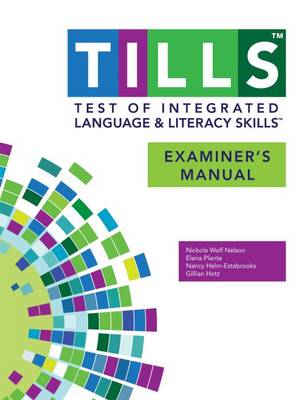 The Test of Integrated Language & Literacy Skills (TILLS) is an assessment of oral and written language abilities in students 6–18 years of age. Published in the Fall 2015, it is unique in the way that it is aimed to thoroughly assess skills such as reading fluency, reading comprehension, phonological awareness, spelling, as well as writing in school age children. As I have been using this test since the time it was published, I wanted to take an opportunity today to share just a few of my impressions of this assessment.
The Test of Integrated Language & Literacy Skills (TILLS) is an assessment of oral and written language abilities in students 6–18 years of age. Published in the Fall 2015, it is unique in the way that it is aimed to thoroughly assess skills such as reading fluency, reading comprehension, phonological awareness, spelling, as well as writing in school age children. As I have been using this test since the time it was published, I wanted to take an opportunity today to share just a few of my impressions of this assessment.
First, a little background on why I chose to purchase this test so shortly after I had purchased the Clinical Evaluation of Language Fundamentals – 5 (CELF-5). Soon after I started using the CELF-5 I noticed that it tended to considerably overinflate my students’ scores on a variety of its subtests. In fact, I noticed that unless a student had a fairly severe degree of impairment, the majority of his/her scores came out either low/slightly below average (click for more info on why this was happening HERE, HERE, or HERE). Consequently, I was excited to hear regarding TILLS development, almost simultaneously through ASHA as well as SPELL-Links ListServe. I was particularly happy because I knew some of this test’s developers (e.g., Dr. Elena Plante, Dr. Nickola Nelson) have published solid research in the areas of psychometrics and literacy respectively.
According to the TILLS developers it has been standardized for 3 purposes:
- to identify language and literacy disorders
- to document patterns of relative strengths and weaknesses
- to track changes in language and literacy skills over time
The testing subtests can be administered in isolation (with the exception of a few) or in its entirety. The administration of all the 15 subtests may take approximately an hour and a half, while the administration of the core subtests typically takes ~45 mins).
Please note that there are 5 subtests that should not be administered to students 6;0-6;5 years of age because many typically developing students are still mastering the required skills.
- Subtest 5 – Nonword Spelling
- Subtest 7 – Reading Comprehension
- Subtest 10 – Nonword Reading
- Subtest 11 – Reading Fluency
- Subtest 12 – Written Expression
However, if needed, there are several tests of early reading and writing abilities which are available for assessment of children under 6:5 years of age with suspected literacy deficits (e.g., TERA-3: Test of Early Reading Ability–Third Edition; Test of Early Written Language, Third Edition-TEWL-3, etc.).
Let’s move on to take a deeper look at its subtests. Please note that for the purposes of this review all images came directly from and are the property of Brookes Publishing Co (clicking on each of the below images will take you directly to their source).
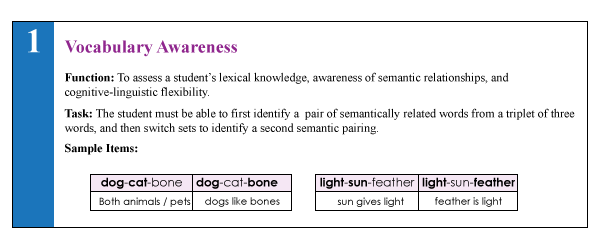 1. Vocabulary Awareness (VA) (description above) requires students to display considerable linguistic and cognitive flexibility in order to earn an average score. It works great in teasing out students with weak vocabulary knowledge and use, as well as students who are unable to quickly and effectively analyze words for deeper meaning and come up with effective definitions of all possible word associations. Be mindful of the fact that even though the words are presented to the students in written format in the stimulus book, the examiner is still expected to read all the words to the students. Consequently, students with good vocabulary knowledge and strong oral language abilities can still pass this subtest despite the presence of significant reading weaknesses. Recommendation: I suggest informally checking the student’s word reading abilities by asking them to read of all the words, before reading all the word choices to them. This way you can informally document any word misreadings made by the student even in the presence of an average subtest score.
1. Vocabulary Awareness (VA) (description above) requires students to display considerable linguistic and cognitive flexibility in order to earn an average score. It works great in teasing out students with weak vocabulary knowledge and use, as well as students who are unable to quickly and effectively analyze words for deeper meaning and come up with effective definitions of all possible word associations. Be mindful of the fact that even though the words are presented to the students in written format in the stimulus book, the examiner is still expected to read all the words to the students. Consequently, students with good vocabulary knowledge and strong oral language abilities can still pass this subtest despite the presence of significant reading weaknesses. Recommendation: I suggest informally checking the student’s word reading abilities by asking them to read of all the words, before reading all the word choices to them. This way you can informally document any word misreadings made by the student even in the presence of an average subtest score.
2. The Phonemic Awareness (PA) subtest (description above) requires students to isolate and delete initial sounds in words of increasing complexity. While this subtest does not require sound isolation and deletion in various word positions, similar to tests such as the CTOPP-2: Comprehensive Test of Phonological Processing–Second Edition or the The Phonological Awareness Test 2 (PAT 2), it is still a highly useful and reliable measure of phonemic awareness (as one of many precursors to reading fluency success). This is especially because after the initial directions are given, the student is expected to remember to isolate the initial sounds in words without any prompting from the examiner. Thus, this task also indirectly tests the students’ executive function abilities in addition to their phonemic awareness skills.
3. The Story Retelling (SR) subtest (description above) requires students to do just that retell a story. Be mindful of the fact that the presented stories have reduced complexity. Thus, unless the students possess significant retelling deficits, the above subtest may not capture their true retelling abilities. Recommendation: Consider supplementing this subtest with informal narrative measures. For younger children (kindergarten and first grade) I recommend using wordless picture books to perform a dynamic assessment of their retelling abilities following a clinician’s narrative model (e.g., HERE). For early elementary aged children (grades 2 and up), I recommend using picture books, which are first read to and then retold by the students with the benefit of pictorial but not written support. Finally, for upper elementary aged children (grades 4 and up), it may be helpful for the students to retell a book or a movie seen recently (or liked significantly) by them without the benefit of visual support all together (e.g., HERE).
4. The Nonword Repetition (NR) subtest (description above) requires students to repeat nonsense words of increasing length and complexity. Weaknesses in the area of nonword repetition have consistently been associated with language impairments and learning disabilities due to the task’s heavy reliance on phonological segmentation as well as phonological and lexical knowledge (Leclercq, Maillart, Majerus, 2013). Thus, both monolingual and simultaneously bilingual children with language and literacy impairments will be observed to present with patterns of segment substitutions (subtle substitutions of sounds and syllables in presented nonsense words) as well as segment deletions of nonword sequences more than 2-3 or 3-4 syllables in length (depending on the child’s age).
5. The Nonword Spelling (NS) subtest (description above) requires the students to spell nonwords from the Nonword Repetition (NR) subtest. Consequently, the Nonword Repetition (NR) subtest needs to be administered prior to the administration of this subtest in the same assessment session. In contrast to the real-word spelling tasks, students cannot memorize the spelling of the presented words, which are still bound by orthographic and phonotactic constraints of the English language. While this is a highly useful subtest, is important to note that simultaneously bilingual children may present with decreased scores due to vowel errors. Consequently, it is important to analyze subtest results in order to determine whether dialectal differences rather than a presence of an actual disorder is responsible for the error patterns.
6. The Listening Comprehension (LC) subtest (description above) requires the students to listen to short stories and then definitively answer story questions via available answer choices, which include: “Yes”, “No’, and “Maybe”. This subtest also indirectly measures the students’ metalinguistic awareness skills as they are needed to detect when the text does not provide sufficient information to answer a particular question definitively (e.g., “Maybe” response may be called for). Be mindful of the fact that because the students are not expected to provide sentential responses to questions it may be important to supplement subtest administration with another listening comprehension assessment. Tests such as the Listening Comprehension Test-2 (LCT-2), the Listening Comprehension Test-Adolescent (LCT-A), or the Executive Function Test-Elementary (EFT-E) may be useful if language processing and listening comprehension deficits are suspected or reported by parents or teachers. This is particularly important to do with students who may be ‘good guessers’ but who are also reported to present with word-finding difficulties at sentence and discourse levels.
7. The Reading Comprehension (RC) subtest (description above) requires the students to read short story and answer story questions in “Yes”, “No’, and “Maybe” format. This subtest is not stand alone and must be administered immediately following the administration the Listening Comprehension subtest. The student is asked to read the first story out loud in order to determine whether s/he can proceed with taking this subtest or discontinue due to being an emergent reader. The criterion for administration of the subtest is making 7 errors during the reading of the first story and its accompanying questions. Unfortunately, in my clinical experience this subtest is not always accurate at identifying children with reading-based deficits.
While I find it terrific for students with severe-profound reading deficits and/or below average IQ, a number of my students with average IQ and moderately impaired reading skills managed to pass it via a combination of guessing and luck despite being observed to misread aloud between 40-60% of the presented words. Be mindful of the fact that typically such students may have up to 5-6 errors during the reading of the first story. Thus, according to administration guidelines these students will be allowed to proceed and take this subtest. They will then continue to make text misreadings during each story presentation (you will know that by asking them to read each story aloud vs. silently). However, because the response mode is in definitive (“Yes”, “No’, and “Maybe”) vs. open ended question format, a number of these students will earn average scores by being successful guessers. Recommendation: I highly recommend supplementing the administration of this subtest with grade level (or below grade level) texts (see HERE and/or HERE), to assess the student’s reading comprehension informally.
I present a full one page text to the students and ask them to read it to me in its entirety. I audio/video record the student’s reading for further analysis (see Reading Fluency section below). After the completion of the story I ask the student questions with a focus on main idea comprehension and vocabulary definitions. I also ask questions pertaining to story details. Depending on the student’s age I may ask them abstract/ factual text questions with and without text access. Overall, I find that informal administration of grade level (or even below grade-level) texts coupled with the administration of standardized reading tests provides me with a significantly better understanding of the student’s reading comprehension abilities rather than administration of standardized reading tests alone.
8. The Following Directions (FD) subtest (description above) measures the student’s ability to execute directions of increasing length and complexity. It measures the student’s short-term, immediate and working memory, as well as their language comprehension. What is interesting about the administration of this subtest is that the graphic symbols (e.g., objects, shapes, letter and numbers etc.) the student is asked to modify remain covered as the instructions are given (to prevent visual rehearsal). After being presented with the oral instruction the students are expected to move the card covering the stimuli and then to executive the visual-spatial, directional, sequential, and logical if–then the instructions by marking them on the response form. The fact that the visual stimuli remains covered until the last moment increases the demands on the student’s memory and comprehension. The subtest was created to simulate teacher’s use of procedural language (giving directions) in classroom setting (as per developers).
9. The Delayed Story Retelling (DSR) subtest (description above) needs to be administered to the students during the same session as the Story Retelling (SR) subtest, approximately 20 minutes after the SR subtest administration. Despite the relatively short passage of time between both subtests, it is considered to be a measure of long-term memory as related to narrative retelling of reduced complexity. Here, the examiner can compare student’s performance to determine whether the student did better or worse on either of these measures (e.g., recalled more information after a period of time passed vs. immediately after being read the story). However, as mentioned previously, some students may recall this previously presented story fairly accurately and as a result may obtain an average score despite a history of teacher/parent reported long-term memory limitations. Consequently, it may be important for the examiner to supplement the administration of this subtest with a recall of a movie/book recently seen/read by the student (a few days ago) in order to compare both performances and note any weaknesses/limitations.
10. The Nonword Reading (NR) subtest (description above) requires students to decode nonsense words of increasing length and complexity. What I love about this subtest is that the students are unable to effectively guess words (as many tend to routinely do when presented with real words). Consequently, the presentation of this subtest will tease out which students have good letter/sound correspondence abilities as well as solid orthographic, morphological and phonological awareness skills and which ones only memorized sight words and are now having difficulty decoding unfamiliar words as a result. 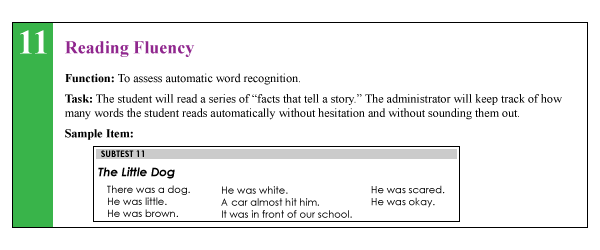
11. The Reading Fluency (RF) subtest (description above) requires students to efficiently read facts which make up simple stories fluently and correctly. Here are the key to attaining an average score is accuracy and automaticity. In contrast to the previous subtest, the words are now presented in meaningful simple syntactic contexts.
It is important to note that the Reading Fluency subtest of the TILLS has a negatively skewed distribution. As per authors, “a large number of typically developing students do extremely well on this subtest and a much smaller number of students do quite poorly.”
Thus, “the mean is to the left of the mode” (see publisher’s image below). This is why a student could earn an average standard score (near the mean) and a low percentile rank when true percentiles are used rather than NCE percentiles (Normal Curve Equivalent). 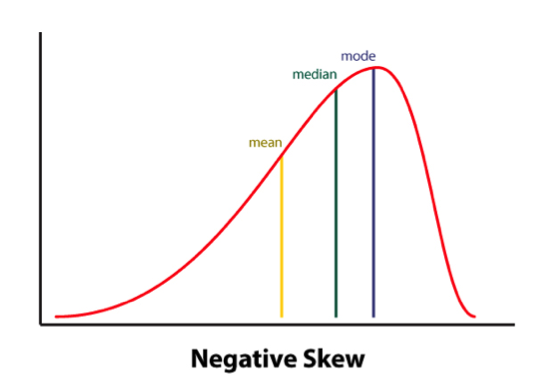
Consequently under certain conditions (See HERE) the percentile rank (vs. the NCE percentile) will be a more accurate representation of the student’s ability on this subtest.
Indeed, due to the reduced complexity of the presented words some students (especially younger elementary aged) may obtain average scores and still present with serious reading fluency deficits.
I frequently see that in students with average IQ and go to long-term memory, who by second and third grades have managed to memorize an admirable number of sight words due to which their deficits in the areas of reading appeared to be minimized. Recommendation: If you suspect that your student belongs to the above category I highly recommend supplementing this subtest with an informal measure of reading fluency. This can be done by presenting to the student a grade level text (I find science and social studies texts particularly useful for this purpose) and asking them to read several paragraphs from it (see HERE and/or HERE).
As the students are reading I calculate their reading fluency by counting the number of words they read per minute. I find it very useful as it allows me to better understand their reading profile (e.g, fast/inaccurate reader, slow/inaccurate reader, slow accurate reader, fast/accurate reader). As the student is reading I note their pauses, misreadings, word-attack skills and the like. Then, I write a summary comparing the students reading fluency on both standardized and informal assessment measures in order to document students strengths and limitations.
12. The Written Expression (WE) subtest (description above) needs to be administered to the students immediately after the administration of the Reading Fluency (RF) subtest because the student is expected to integrate a series of facts presented in the RF subtest into their writing sample. There are 4 stories in total for the 4 different age groups.
The examiner needs to show the student a different story which integrates simple facts into a coherent narrative. After the examiner reads that simple story to the students s/he is expected to tell the students that the story is okay, but “sounds kind of “choppy.” They then need to show the student an example of how they could put the facts together in a way that sounds more interesting and less choppy by combining sentences (see below). Finally, the examiner will ask the students to rewrite the story presented to them in a similar manner (e.g, “less choppy and more interesting.”)
After the student finishes his/her story, the examiner will analyze it and generate the following scores: a discourse score, a sentence score, and a word score. Detailed instructions as well as the Examiner’s Practice Workbook are provided to assist with scoring as it takes a bit of training as well as trial and error to complete it, especially if the examiners are not familiar with certain procedures (e.g., calculating T-units).
Full disclosure: Because the above subtest is still essentially sentence combining, I have only used this subtest a handful of times with my students. Typically when I’ve used it in the past, most of my students fell in two categories: those who failed it completely by either copying text word for word, failing to generate any written output etc. or those who passed it with flying colors but still presented with notable written output deficits. Consequently, I’ve replaced Written Expression subtest administration with the administration of written standardized tests, which I supplement with an informal grade level expository, persuasive, or narrative writing samples.
Having said that many clinicians may not have the access to other standardized written assessments, or lack the time to administer entire standardized written measures (which may frequently take between 60 to 90 minutes of administration time). Consequently, in the absence of other standardized writing assessments, this subtest can be effectively used to gauge the student’s basic writing abilities, and if needed effectively supplemented by informal writing measures (mentioned above).
13. The Social Communication (SC) subtest (description above) assesses the students’ ability to understand vocabulary associated with communicative intentions in social situations. It requires students to comprehend how people with certain characteristics might respond in social situations by formulating responses which fit the social contexts of those situations. Essentially students become actors who need to act out particular scenes while viewing select words presented to them.
Full disclosure: Similar to my infrequent administration of the Written Expression subtest, I have also administered this subtest very infrequently to students. Here is why.
I am an SLP who works full-time in a psychiatric hospital with children diagnosed with significant psychiatric impairments and concomitant language and literacy deficits. As a result, a significant portion of my job involves comprehensive social communication assessments to catalog my students’ significant deficits in this area. Yet, past administration of this subtest showed me that number of my students can pass this subtest quite easily despite presenting with notable and easily evidenced social communication deficits. Consequently, I prefer the administration of comprehensive social communication testing when working with children in my hospital based program or in my private practice, where I perform independent comprehensive evaluations of language and literacy (IEEs).
Again, as I’ve previously mentioned many clinicians may not have the access to other standardized social communication assessments, or lack the time to administer entire standardized written measures. Consequently, in the absence of other social communication assessments, this subtest can be used to get a baseline of the student’s basic social communication abilities, and then be supplemented with informal social communication measures such as the Informal Social Thinking Dynamic Assessment Protocol (ISTDAP) or observational social pragmatic checklists.
14. The Digit Span Forward (DSF) subtest (description above) is a relatively isolated measure of short term and verbal working memory ( it minimizes demands on other aspects of language such as syntax or vocabulary).
15. The Digit Span Backward (DSB) subtest (description above) assesses the student’s working memory and requires the student to mentally manipulate the presented stimuli in reverse order. It allows examiner to observe the strategies (e.g. verbal rehearsal, visual imagery, etc.) the students are using to aid themselves in the process. Please note that the Digit Span Forward subtest must be administered immediately before the administration of this subtest.
SLPs who have used tests such as the Clinical Evaluation of Language Fundamentals – 5 (CELF-5) or the Test of Auditory Processing Skills – Third Edition (TAPS-3) should be highly familiar with both subtests as they are fairly standard measures of certain aspects of memory across the board.
To continue, in addition to the presence of subtests which assess the students literacy abilities, the TILLS also possesses a number of interesting features.
For starters, the TILLS Easy Score, which allows the examiners to use their scoring online. It is incredibly easy and effective. After clicking on the link and filling out the preliminary demographic information, all the examiner needs to do is to plug in this subtest raw scores, the system does the rest. After the raw scores are plugged in, the system will generate a PDF document with all the data which includes (but is not limited to) standard scores, percentile ranks, as well as a variety of composite and core scores. The examiner can then save the PDF on their device (laptop, PC, tablet etc.) for further analysis.
The there is the quadrant model. According to the TILLS sampler (HERE) “it allows the examiners to assess and compare students’ language-literacy skills at the sound/word level and the sentence/ discourse level across the four oral and written modalities—listening, speaking, reading, and writing” and then create “meaningful pro files of oral and written language skills that will help you understand the strengths and needs of individual students and communicate about them in a meaningful way with teachers, parents, and students. (pg. 21)”
Then there is the Student Language Scale (SLS) which is a one page checklist parents, teachers (and even students) can fill out to informally identify language and literacy based strengths and weaknesses. It allows for meaningful input from multiple sources regarding the students performance (as per IDEA 2004) and can be used not just with TILLS but with other tests or in even isolation (as per developers).
Furthermore according to the developers, because the normative sample included several special needs populations, the TILLS can be used with students diagnosed with ASD, deaf or hard of hearing (see caveat), as well as intellectual disabilities (as long as they are functioning age 6 and above developmentally).
According to the developers the TILLS is aligned with Common Core Standards and can be administered as frequently as two times a year for progress monitoring (min of 6 mos post 1st administration).
With respect to bilingualism examiners can use it with caution with simultaneous English learners but not with sequential English learners (see further explanations HERE). Translations of TILLS are definitely not allowed as they will undermine test validity and reliability.
So there you have it these are just some of my very few impressions regarding this test. Now to some of you may notice that I spend a significant amount of time pointing out some of the tests limitations. However, it is very important to note that we have research that indicates that there is no such thing as a “perfect standardized test” (see HERE for more information). All standardized tests have their limitations.
Having said that, I think that TILLS is a PHENOMENAL addition to the standardized testing market, as it TRULY appears to assess not just language but also literacy abilities of the students on our caseloads.
That’s all from me; however, before signing off I’d like to provide you with more resources and information, which can be reviewed in reference to TILLS. For starters, take a look at Brookes Publishing TILLS resources. These include (but are not limited to) TILLS FAQ, TILLS Easy-Score, TILLS Correction Document, as well as 3 FREE TILLS Webinars. There’s also a Facebook Page dedicated exclusively to TILLS updates (HERE).
But that’s not all. Dr. Nelson and her colleagues have been tirelessly lecturing about the TILLS for a number of years, and many of their past lectures and presentations are available on the ASHA website as well as on the web (e.g., HERE, HERE, HERE, etc). Take a look at them as they contain far more in-depth information regarding the development and implementation of this groundbreaking assessment.
To access TILLS fully-editable template, click HERE
Disclaimer: I did not receive a complimentary copy of this assessment for review nor have I received any encouragement or compensation from either Brookes Publishing or any of the TILLS developers to write it. All images of this test are direct property of Brookes Publishing (when clicked on all the images direct the user to the Brookes Publishing website) and were used in this post for illustrative purposes only.
References:
Leclercq A, Maillart C, Majerus S. (2013) Nonword repetition problems in children with SLI: A deficit in accessing long-term linguistic representations? Topics in Language Disorders. 33 (3) 238-254.
Related Posts:
- Components of Comprehensive Dyslexia Testing: Part I- Introduction and Language Testing
- Part II: Components of Comprehensive Dyslexia Testing – Phonological Awareness and Word Fluency Assessment
- Part III: Components of Comprehensive Dyslexia Testing – Reading Fluency and Reading Comprehension
- Part IV: Components of Comprehensive Dyslexia Testing – Writing and Spelling
- Special Education Disputes and Comprehensive Language Testing: What Parents, Attorneys, and Advocates Need to Know
- Why (C) APD Diagnosis is NOT Valid!
- What Are Speech Pathologists To Do If the (C)APD Diagnosis is NOT Valid?
- What do Auditory Memory Deficits Indicate in the Presence of Average General Language Scores?
- Why Are My Child’s Test Scores Dropping?
- Comprehensive Assessment of Adolescents with Suspected Language and Literacy Disorders
Embracing ‘Translanguaging’ Practices: A Tutorial for SLPs

Please note that this post was originally published in the Summer 2016 NJSHA’s VOICES (available HERE).
If you have been keeping up with new developments in the field of bilingualism then you’ve probably heard the term “translanguaging,” increasingly mentioned at bilingual conferences across the nation. If you haven’t, ‘translanguaging’ is the “ability of multilingual speakers to shuttle between languages, treating the diverse languages that form their repertoire as an integrated system” (Canagarajah, 2011, p. 401). In other words, translanguaging allows bilinguals to make “flexible use their linguistic resources to make meaning of their lives and their complex worlds” (Garcia, 2011, pg. 1).
 Wait a second, you might say! “Isn’t that a definition of ‘code-switching’?” And the answer is: “No!” The concept of ‘code-switching’ implies that bilinguals use two separate linguistic codes which do not overlap/reference each other. In contrast, ‘translanguaging’ assumes from the get-go that “bilinguals have one linguistic repertoire from which they select features strategically to communicate effectively” (Garcia, 2012, pg. 1). Bilinguals engage in translanguaging on an ongoing basis in their daily lives. They speak different languages to different individuals, find ‘Google’ translations of words and compare results from various online sites, listen to music in one language but watch TV in another, as well as watch TV announcers fluidly integrate several languages in their event narratives during news or in infomercials (Celic & Seltzer, 2011). For functional bilinguals, these practices are such integral part of their daily lives that they rarely realize just how much ‘translanguaging’ they actually do every day.
Wait a second, you might say! “Isn’t that a definition of ‘code-switching’?” And the answer is: “No!” The concept of ‘code-switching’ implies that bilinguals use two separate linguistic codes which do not overlap/reference each other. In contrast, ‘translanguaging’ assumes from the get-go that “bilinguals have one linguistic repertoire from which they select features strategically to communicate effectively” (Garcia, 2012, pg. 1). Bilinguals engage in translanguaging on an ongoing basis in their daily lives. They speak different languages to different individuals, find ‘Google’ translations of words and compare results from various online sites, listen to music in one language but watch TV in another, as well as watch TV announcers fluidly integrate several languages in their event narratives during news or in infomercials (Celic & Seltzer, 2011). For functional bilinguals, these practices are such integral part of their daily lives that they rarely realize just how much ‘translanguaging’ they actually do every day.
 One of the most useful features of translanguaging (and there are many) is that it assists with further development of bilinguals’ metalinguistic awareness abilities by allowing them to compare language practices as well as explicitly notice language features. Consequently, not only do speech-language pathologists (SLPs) need to be aware of translanguaging when working with culturally diverse clients, they can actually assist their clients make greater linguistic gains by embracing translanguaging practices. Furthermore, one does not have to be a bilingual SLP to incorporate translanguaging practices in the therapy room. Monolingual SLPs can certainly do it as well, and with a great degree of success.
One of the most useful features of translanguaging (and there are many) is that it assists with further development of bilinguals’ metalinguistic awareness abilities by allowing them to compare language practices as well as explicitly notice language features. Consequently, not only do speech-language pathologists (SLPs) need to be aware of translanguaging when working with culturally diverse clients, they can actually assist their clients make greater linguistic gains by embracing translanguaging practices. Furthermore, one does not have to be a bilingual SLP to incorporate translanguaging practices in the therapy room. Monolingual SLPs can certainly do it as well, and with a great degree of success.
 Here are some strategies of how this can be accomplished. Let us begin with bilingual SLPs who have the ability to do therapy in both languages. One great way to incorporate translanguaging in therapy is to alternate between English and the desired language (e.g., Spanish) throughout the session. Translanguaging strategies may include: using key vocabulary, grammar and syntax structures in both languages (side to side), alternating between English and Spanish websites when researching specific information (e.g., an animal habitats, etc.), asking students to take notes in both languages or combining two languages in one piece of writing. For younger preschool students, reading the same book, translated in another language is also a viable option as it increases their lexicon in both languages.
Here are some strategies of how this can be accomplished. Let us begin with bilingual SLPs who have the ability to do therapy in both languages. One great way to incorporate translanguaging in therapy is to alternate between English and the desired language (e.g., Spanish) throughout the session. Translanguaging strategies may include: using key vocabulary, grammar and syntax structures in both languages (side to side), alternating between English and Spanish websites when researching specific information (e.g., an animal habitats, etc.), asking students to take notes in both languages or combining two languages in one piece of writing. For younger preschool students, reading the same book, translated in another language is also a viable option as it increases their lexicon in both languages.
 Those SLPs who treat ESL students with language disorders and collaborate with ESL teachers can design thematic intervention with a focus on particular topics of interest. For example, during the month of April there’s increased attention on the topic of ‘human impact on the environment.’ Students can read texts on this topic in English and then use the internet to look up websites containing the information in their birth language. They can also listen to a translation or a summary of the English book in their birth language. Finally, they can make comparisons of human impact on the environment between United States and their birth/heritage countries.
Those SLPs who treat ESL students with language disorders and collaborate with ESL teachers can design thematic intervention with a focus on particular topics of interest. For example, during the month of April there’s increased attention on the topic of ‘human impact on the environment.’ Students can read texts on this topic in English and then use the internet to look up websites containing the information in their birth language. They can also listen to a translation or a summary of the English book in their birth language. Finally, they can make comparisons of human impact on the environment between United States and their birth/heritage countries.
As we are treating culturally and linguistically diverse students it is important to use self-questions such as: “Can we connect a particular content-area topic to our students’ cultures?” or “Can we include different texts or resources in sessions which represent our students’ multicultural perspectives?” which can assist us in making best decisions in their care (Celic & Seltzer, 2011).
 We can “Get to know our students” by displaying a world map in our therapy room/classroom and asking them to show us where they were born or came from (or where their family is from). We can label the map with our students’ names and photographs and provide them with the opportunity to discuss their culture and develop cultural connections. We can create a multilingual therapy room by using multilingual labels and word walls as well as sprinkling our English language therapy with words relevant to the students from their birth/heritage languages (e.g., songs and greetings, etc.).
We can “Get to know our students” by displaying a world map in our therapy room/classroom and asking them to show us where they were born or came from (or where their family is from). We can label the map with our students’ names and photographs and provide them with the opportunity to discuss their culture and develop cultural connections. We can create a multilingual therapy room by using multilingual labels and word walls as well as sprinkling our English language therapy with words relevant to the students from their birth/heritage languages (e.g., songs and greetings, etc.).

Monolingual SLPs who do not speak the child’s language or speak it very limitedly, can use multilingual books which contain words from other languages. To introduce just a few words in Spanish, books such as ‘Maňana Iguana’ by Ann Whitford Paul, ‘Count on Culebra’ by Ann Whitford Paul, ‘Abuela’ by Arthur Doros, or ‘Old man and his door’ by Gary Soto can be used. SLPs with greater proficiency in a particular language (e.g., Russian) they consider using dual bilingual books in sessions (e.g., ‘Goldilocks and the Three Bears’ by Kate Clynes, ‘Giant Turnip’ by Henriette Barkow. All of these books can be found on such websites as ‘Amazon’ (string search: children’s foreign language books), ‘Language Lizard’ or ‘Trilingual Mama’ (contains list of free online multilingual books).
It is also important to understand that many of our language impaired bilingual students have a very limited knowledge of the world beyond the “here and now.” Many upper elementary and middle school youngsters have difficulty naming world’s continents, and do not know the names and capitals of major countries. That is why it is also important to teach them general concepts of geography, discuss world’s counties and the people who live there, as well as introduce them to select multicultural holidays celebrated in United States and in other countries around the world.
All students benefit from translanguaging! It increases awareness of language diversity in monolingual students, validates use of home languages for bilingual students, as well as assists with teaching challenging academic content and development of English for emergent bilingual students. Translanguaging can take place in any classroom or therapy room with any group of children including those with primary language impairments or those speaking different languages from one another. The cognitive benefits of translanguaging are numerous because it allows students to use all of their languages as a resource for learning, reading, writing, and thinking in the classroom (Celic & Seltzer, 2011).
References:
- Canagarajah, A. S. (2011). Codemeshing in academic writing: Identifying teachable strategies of translanguaging. The Modern Language Journal, 95, 401-417.
- García, O. (2011).Theorizing translanguaging for educators. In C. Celic & K. Seltzer, Translanguaging: A CUNY-NYSIEB guide for educators, 1-6.
Helpful Smart Speech Therapy Resources:
Teaching Metalinguistic Vocabulary for Reading Success
 In my therapy sessions I spend a significant amount of time improving literacy skills (reading, spelling, and writing) of language impaired students. In my work with these students I emphasize goals with a focus on phonics, phonological awareness, encoding (spelling) etc. However, what I have frequently observed in my sessions are significant gaps in the students’ foundational knowledge pertaining to the basics of sound production and letter recognition. Basic examples of these foundational deficiencies involve students not being able to fluently name the letters of the alphabet, understand the difference between vowels and consonants, or fluently engage in sound/letter correspondence tasks (e.g., name a letter and then quickly and accurately identify which sound it makes). Consequently, a significant portion of my sessions involves explicit instruction of the above concepts.
In my therapy sessions I spend a significant amount of time improving literacy skills (reading, spelling, and writing) of language impaired students. In my work with these students I emphasize goals with a focus on phonics, phonological awareness, encoding (spelling) etc. However, what I have frequently observed in my sessions are significant gaps in the students’ foundational knowledge pertaining to the basics of sound production and letter recognition. Basic examples of these foundational deficiencies involve students not being able to fluently name the letters of the alphabet, understand the difference between vowels and consonants, or fluently engage in sound/letter correspondence tasks (e.g., name a letter and then quickly and accurately identify which sound it makes). Consequently, a significant portion of my sessions involves explicit instruction of the above concepts.
This got me thinking regarding my students’ vocabulary knowledge in general. We, SLPs, spend a significant amount of time on explicit and systematic vocabulary instruction with our students because as compared to typically developing peers, they have immature and limited vocabulary knowledge. But do we teach our students the abstract vocabulary necessary for reading success? Do we explicitly teach them definitions of a letter, a word, a sentence? etc.
A number of my colleagues are skeptical. “Our students already have poor comprehension”, they tell me, “Why should we tax their memory with abstract words of little meaning to them?” And I agree with them of course, but up to a point.
I agree that our students have working memory and processing speed deficits as a result of which they have a much harder time learning and recalling new words.
However, I believe that not teaching them meanings of select words pertaining to language is a huge disservice to them. Here is why. To be a successful communicator, speaker, reader, and writer, individuals need to possess adequate metalinguistic skills.
In simple terms “metalinguistics” refers to the individual’s ability to actively think about, talk about, and manipulate language. Reading, writing, and spelling require active level awareness and thought about language. Students with poor metalinguistic skills have difficulty learning to read, write, and spell. They lack awareness that spoken words are made up of individual units of sound, which can be manipulated. They lack awareness that letters form words, words form phrases and sentences, and sentences form paragraphs. They may not understand that letters make sounds or that a word may consist of more letters than sounds (e.g., /ship/). The bottom line is that students with decreased metalinguistic skills cannot effectively use language to talk about concepts like sounds, letters, or words unless they are explicitly taught those abilities.
 So I do! Furthermore, I can tell you that explicit instruction of metalinguistic vocabulary does significantly improve my students understanding of the tasks involved in obtaining literacy competence. Even my students with mild to moderate intellectual disabilities significantly benefit from understanding the meanings of: letters, words, sentences, etc.
So I do! Furthermore, I can tell you that explicit instruction of metalinguistic vocabulary does significantly improve my students understanding of the tasks involved in obtaining literacy competence. Even my students with mild to moderate intellectual disabilities significantly benefit from understanding the meanings of: letters, words, sentences, etc.
I even created a basic abstract vocabulary handout to facilitate my students comprehension of these words (FREE HERE). While by no means exhaustive, it is a decent starting point for teaching my students the vocabulary needed to improve their metalinguistic skills.
For older elementary aged students with average IQ, I only provide the words I want them to define, and then ask them to look up their meanings online via the usage of PC or an iPad. This turns of vocabulary activity into a critical thinking and an executive functions task.
Students need to figure out the appropriate search string needed to in order to locate the answer as well as which definition comes the closest to clearly and effectively defining the presented word. One of the things I really like about Google online dictionary, is that it provides multiple definitions of the same words along with word origins. As a result, it teaches students to carefully review and reflect upon their selected definition in order to determine its appropriateness.
 A word of caution as though regarding using Kiddle, Google-powered search engine for children. While it’s great for locating child friendly images, it is not appropriate for locating abstract definition of words. To illustrate, when you type in the string search into Google, “what is the definition of a letter?” You will get several responses which will appropriately match some meanings of your query. However the same string search in Kiddle, will merely yield helpful tips on writing a letter as well as images of envelopes with stamps affixed to them.
A word of caution as though regarding using Kiddle, Google-powered search engine for children. While it’s great for locating child friendly images, it is not appropriate for locating abstract definition of words. To illustrate, when you type in the string search into Google, “what is the definition of a letter?” You will get several responses which will appropriately match some meanings of your query. However the same string search in Kiddle, will merely yield helpful tips on writing a letter as well as images of envelopes with stamps affixed to them.
In contrast to the above, I use a more structured vocabulary defining activities for younger elementary age students as well as students with intellectual impairments. I provide simple definitions of abstract words, attach images and examples to each definition as well as create cloze activities and several choices of answers in order to ensure my students’ comprehension of these words.
I find that this and other metalinguistic activities significantly improve my students comprehension of abstract words such as ‘communication’, ‘language’, as well as ‘literacy’. They cease being mere buzzwords, frequently heard yet consistently not understood. To my students these words begin to come to life, brim with meaning, and inspire numerous ‘aha’ moments.
Now that you’ve had a glimpse of my therapy sessions I’d love to have a glimpse of yours. What metalinguistic goals related to literacy are you targeting with your students? Comment below to let me know.

Friend or Friendly: What Does Age Have To Do with It?
 In my social pragmatic language groups I target a wide variety of social communication goals for children with varying levels and degrees of impairment with a focus on improving their social pragmatic language competence. In the past I have written blog posts on a variety of social pragmatic language therapy topics, including strategies for improving students’ emotional intelligence as well as on how to teach students to develop insight into own strengths and weaknesses. Today I wanted to discuss the importance of teaching students with social communication impairments, age recognition for friendship and safety purposes.
In my social pragmatic language groups I target a wide variety of social communication goals for children with varying levels and degrees of impairment with a focus on improving their social pragmatic language competence. In the past I have written blog posts on a variety of social pragmatic language therapy topics, including strategies for improving students’ emotional intelligence as well as on how to teach students to develop insight into own strengths and weaknesses. Today I wanted to discuss the importance of teaching students with social communication impairments, age recognition for friendship and safety purposes.
Now it is important to note that the focus of my sessions is a bit different from the focus of “teaching protective behaviors”, “circles of intimacy and relationships” or “teaching kids to deal with tricky people“. Rather the goal is to teach the students to recognize who it is okay “to hang out” or be friends with, and who is considered to be too old/too young to be a friend.

Why is it important to teach age recognition?
There are actually quite a few reasons.
Firstly, it is a fairly well-known fact that in the absence of age-level peers with similar weaknesses, students with social communication deficits will seek out either much younger or much older children as playmates/friends as these individuals are far less likely to judge them for their perceived social deficits. While this may be a short-term solution to the “friendship problem” it also comes with its own host of challenges. By maintaining relationships with peers outside of their age group, it is difficult for children with social communication impairments to understand and relate to peers of their age group in school setting. This creates a wider chasm in the classroom and increases the risk of peer isolation and bullying.
Secondly, the difficulty presented by friendships significantly outside of one’s peer group, is the risk of, for lack of better words, ‘getting into trouble’. This may include but is not limited to exploring own sexuality (which is perfectly normal) with a significantly younger child (which can be problematic) or be instigated by an older child/adolescent in doing something inappropriate (e.g, shoplifting, drinking, smoking, exposing self to peers, etc.).
Thirdly, this difficulty (gauging people’s age) further exacerbates the students’ social communication deficits as it prevents them from effectively understanding such pragmatic parameters such as audience (e.g., with whom its appropriate to use certain language in a certain tone and with whom it is not) and topic (with whom it is appropriate to discuss certain subjects and with whom it is not).
![]()
So due to the above reasons I began working on age recognition with the students (6+ years of age) on my caseload diagnosed with social communication and language impairments. I mention language impairments because it is very important to understand that more and more research is coming out connecting language impairments with social communication deficits. Therefore it’s not just students on the autism spectrum or students with social pragmatic deficits (an official DSM-5 diagnosis) who have difficulties in the area of social communication. Students with language impairments could also benefit from services focused on improving their social communication skills.
I begin my therapy sessions on age recognition by presenting the students with photos of people of different ages and asking them to attempt to explain how old do they think the people in the pictures are and what visual clues and/or prior knowledge assisted them in the formulation of their responses. I typically select the pictures from some of the social pragmatic therapy materials packets that I had created over the years (e.g., Gauging Moods, Are You Being Social?, Multiple Interpretations, etc.).
I make sure to carefully choose my pictures based on the student’s age and experience to ensure that the student has at least some degree of success making guesses. So for a six-year-old I would select pictures of either toddlers or children his/her age to begin teaching them recognition of concepts: “same” and “younger” (e.g., Social Pragmatic Photo Bundle for Early Elementary Aged Children).
For older children, I vary the photos of different aged individuals significantly. I also introduce relevant vocabulary words as related to a particular age demographic, such as:
- Infant (0-1 years of age)
- Toddler (2-3 years of age)
- Preschooler (3-5 years of age)
- Teenager (individual between 13-19 years of age)
- Early, mid and late 20s, 30s, 40s
- Middle-aged (individuals around 50 years of age)
- Senior/senior citizen (individuals ~65+ years of age)
I explain to the students that people of different ages look differently and teach them how to identify relevant visual clues to assist them with making educated guesses about people’s ages. I also use photos of my own family or ask the students to bring in their own family photos to use for age determination of people in the presented pictures. When students learn the ages of their own family members, they have an easier time determining the age ranges of strangers.
My next step is to explain to students the importance of understanding people’s ages. I present to the students a picture of an individual significantly younger or older than them and ask them whether it’s appropriate to be that person’s friend. Here students with better developed insight will state that it is not appropriate to be that person’s friend because they have nothing in common with them and do not share their interests. In contrast, students with limited insight will state that it’s perfectly okay to be that person’s friend.
This is the perfect teachable moment for explaining the difference between “friend” and “friendly”. Here I again reiterate that people of different ages have significantly different interests as well as have significant differences in what they are allowed to do (e.g., a 16-year-old is allowed to have a driver’s permit in many US states as well as has a later curfew while an 11-year-old clearly doesn’t). I also explain that it’s perfectly okay to be friendly and polite with older or younger people in social situations (e.g., say hello all, talk, answer questions, etc.) but that does not constitute true friendship.
I also ask students to compile a list of qualities of what they look for in a “friend” as well as have them engage in some perspective taking (e.g, have them imagine that they showed up at a toddler’s house and asked to play with him/her, or that a teenager came into their house, and what their parents reaction would be?).
Finally, I discuss with students the importance of paying attention to who wants to hang out/be friends with them as well as vice versa (individuals they want to hang out with) in order to better develop their insight into the appropriateness of relationships. I instruct them to think critically when an older individual (e.g, young adult) wants to get particularly close to them. I use examples from an excellent post written by a colleague and good friend, Maria Del Duca of Communication Station Blog re: dealing with tricky people, in order to teach them to recognize signs of individuals crossing the boundary of being friendly, and what to do about it.
So there you have it. These are some of the reasons why I teach age recognition to clients with social communication weaknesses. Do you teach age recognition to your clients? If so, comment under this post, how do you do it and what materials do you use?
Helpful Smart Speech Resources Related to Assessment and Treatment of Social Pragmatic Disorders
- Gauging Moods and Interpreting Emotional States
- Social Pragmatic Language Activity Pack
- Social Pragmatic Language: Multiple Interpretations Therapy Activity
- Social Pragmatic Photo Bundle for Early Elementary Aged Children
- Introduction to Social Pragmatic Language Disorders
- Recognizing the Warning Signs of Social Emotional Difficulties in Language Impaired Toddlers and Preschoolers
- Social Pragmatic Deficits Checklist for Preschool Children
- Social Pragmatic Deficits Checklist for School Aged Children
- Social Pragmatic Assessment and Treatment Bundle
- Narrative Assessment Bundle
- Psychiatric Disorders Bundle
- Fetal Alcohol Spectrum Disorders Assessment and Treatment Bundle
- Assessing Social Pragmatic Skills of School Aged Children
- Behavior Management Strategies for Speech Language Pathologists
- Effective Behavior Management Techniques for Parents and Professionals
- Assessment and Treatment of Non-Verbal Language Disorder (NVLD) in Speech Language Pathology
- Treatment of Social Pragmatic Deficits in School Aged Children
- The Role of Frontal Lobe in Speech and Language Functions
- Executive Function Impairments in At-Risk Pediatric Populations
- Differential Diagnosis of ADHD in Speech Language Pathology
- Speech Language Assessment of Older Internationally Adopted Children
- ABBN0002: Early Identification of Language-Based Deficits in Pediatric Populations [Recorded CEU Webinar]
Test Review of CELF-5 Metalinguistics: What SLPs Need to Know
 In mid-2014, I purchased the Clinical Evaluation of Language Fundamentals®, Fifth Edition Metalinguistics (CELF®-5 Metalinguistics), which is a revision of the Test of Language Competence–Expanded.
In mid-2014, I purchased the Clinical Evaluation of Language Fundamentals®, Fifth Edition Metalinguistics (CELF®-5 Metalinguistics), which is a revision of the Test of Language Competence–Expanded.
Basic overview
Release date: 2014
Age Range: 9-21
Author: Elizabeth Wiig and Wayne Secord
Publisher: Pearson
Description: According to the manual CELF–5M was created to “identify students 9-21 years old who have not acquired the expected levels of communicative competence and metalinguistic ability for their age” (pg. 1). In other words the test targets higher level language skills beyond the basic vocabulary and grammar knowledge and use. The authors recommend using this test with students with “subtle language disorders” or “those on the autism spectrum”.
The test contains 5 subtests:
The Metalinguistics Profile subtest of the CELF-5:M is a questionnaire (filled out by caregiver or teacher) which targets three areas: Words, Concepts, and Multiple Meanings; Inferences and Predictions; as well as Conversational Knowledge and Use. Its aim is to obtain information about a student’s metalinguistic skills in everyday educational and social contexts to complement the evidence of metalinguistic strengths and weaknesses identified by the other subtests that comprise the CELF-5:M test battery.
Questions address such topics as the child’s comprehension of idioms and abstract language, their predicting and inferencing abilities, their ability to deal with unpleasant situations, participate in group discussions, as well as understand jokes and sarcasm, just to name a few. A maximum of four points can be obtained on each of it 30 questions. The following is the rating criteria: a score of one is obtained when a child ‘never’ does something in a particular category (e.g., doesn’t get the punchline of jokes). A score of two is given when a child is capable of understanding or using something ‘some of the time’. A score of three is given when a child is able to understand or perform something ‘often’. Finally, a score of four is given when a child is capable of comprehending something ‘always’ or ‘almost always’.
A word of caution, when giving this profile to either teachers or parents to fill out, the SLP must ensure that no overinflation or underestimation of scores takes place. Frequently, some parents may not have a clear understanding of the extent of their child’s level of deficits. Similarly, some teachers, especially those who may not know the child very well, or those who have worked with a child for a very short period of time, may overinflate the scores when filling out the questionnaire. However, the opposite may also occur. A small group of parents may underestimate their children’s abilities, and provide poor scores as a result also not providing an objective picture of the child’s level of deficits. In such situations, the best option may be for the SLP to fill out the questionnaire together with the parent or teacher in order to provide explanations of questions in a different categories.
The Making Inferences subtest of the CELF-5:M evaluates the student’s ability to identify and formulate logical inferences on the basis of existing causal relationships presented in short narrative texts. The student is visually and auditorily presented with a particular situation by the examiner. S/he is then asked to identify the best two out of four written answers for the ending and come up with her own additional reason other than the ones listed in the stimulus book.
On the multiple choice portion of the subtest errors can result due to provision of contradictory, unrelated and irrelevant responses. On the open ended questions portion of the subtest errors can result due to vague, confusing, incomplete, unlikely or illogical responses as well as due to contradictory and off topic answers.
I must say that this is my least favorite subtest. Here’s why. In real life students are not provided with multiple choices when asked to make predictions or inferences. That is why I do not believe that performance on this subtest is a true representation of the child’s ability in this area.
The Conversational Skills subtest of the CELF-5:M evaluates the student’s ability to initiate a conversation or respond in a way that is relevant and pragmatically appropriate to the context and audience while incorporating given words in semantically and syntactically correct sentences. S/he are presented with a picture scene that creates a conversational context and two or three words which are also printed above the pictured scene. S/he are then asked to formulate a conversationally and pragmatically appropriate sentence for the given context using all of the target words in the form (tense, number, etc.) provided.
 Errors on this subtest can result due to pragmatic, semantic or syntactic errors. With respect to pragmatics errors can result due to illogical, nonsensical, vague or incomplete sentences as well as due to sentence formulation which does not take into account presented scenes. With respect to semantics errors can result due to missing or misused target words as well as due to vague, incorrect or misused verbiage. With respect to syntax errors can result due to use of sentence fragments, morphological misuse of target words (changing word forms) as well as syntact deviations on non-target words.
Errors on this subtest can result due to pragmatic, semantic or syntactic errors. With respect to pragmatics errors can result due to illogical, nonsensical, vague or incomplete sentences as well as due to sentence formulation which does not take into account presented scenes. With respect to semantics errors can result due to missing or misused target words as well as due to vague, incorrect or misused verbiage. With respect to syntax errors can result due to use of sentence fragments, morphological misuse of target words (changing word forms) as well as syntact deviations on non-target words.
The Multiple Meanings subtest of the CELF-5:M evaluates the student’s ability to recognize and interpret different meanings of selected lexical (word level) and structural (sentence level) ambiguities. S/he are presented a sentence (orally and in text) that contained an ambiguity at either the word or sentence level. S/he are then asked to describe two meanings for each presented sentence.
Errors can result due to difficulty interpreting lexical and structural ambiguities as well as due to an inability to provide more than one interpretation to presented multiple meaning words.
The Figurative Language subtest of the CELF-5:M evaluates the student’s ability to interpret figurative expressions (idioms) within a given context and match each expression with another figurative expression of similar meaning given verbal and written support.
Errors on this subtest can result due to difficulty explaining the meanings of idiomatic expressions, as well as due to difficulty selecting the appropriate meaning from visually provided multiple choice answers containing related idiomatic expressions.
Based on testing the following long-term goal can be generated:
LTG: Student will improve his/her metalinguistic abilities (thinking about language) for academic and social purposes
It can also yield the following short-term goals
- Student will improve ability to make social inferences with an without written support
- Student will improve ability to to make social predictions with and without written support
- Student will produce (choose one/all: syntactically, semantically, pragmatically) appropriate compound and complex sentences with and without visual support
- Student will improve ability to explain context embedded multiple meaning words
- Student will improve ability to explain ambiguously worded language
- Student will improve ability to explain figurative language and idiomatic expressions
A word of caution regarding testing eligibility:
 What I am concerned about:
What I am concerned about:
- It is rather costly with a sticker price of $376, which is far above other tests assessing similar abilities on the market.
- Test administration begins at 9 years of age. However, metalinguistic abilities develop in children much earlier than nine years of age. Children and young as 6 years of age can present with glaring metalinguistic deficits but unless the examiner has access to another testing which could assess the children’s metalinguistic abilities we have to wait until the child is nine and is clearly behind his or her peers in their metalinguistic development in order to confirm the presence of deficits.
- I also don’t understand the presence of visual and written stimuli on select testing subtests. Children are not provided with multiple-choice answers or written support in daily social and academic situations. As a result of the presence of these aids score overinflation may occur with those children who do well given compensatory strategies but who have difficulty generating novel spontaneous responses.
- Similarly, I am concerned that higher functioning yet socially clueless students may be administered this test because the examiners may believe that it would accurately assess their higher functioning social pragmatic language abilities. However many higher functioning students will pass this test with flying colors, which is why I urge considerable caution when selecting student population for testing administration
- Very Important: See the sensitivity and specificity details of CELF-5M above.
Consequently the CELF-5: M administration is not for everyone. As mentioned before I would only administer portions of this test to higher functioning (but not too high functioning) students undergoing language assessment for the first time or to higher functioning students receiving a re-evaluation, who have previously passed the Clinical Evaluation of Language Fundamentals-5 with ease. This test would not be appropriate for Severely Challenged and Challenged Social Communicators (see Winner, 2015)
I would also not administer this test to the following populations:
- Students with intellectual disabilities
- Students with severe language impairment and limited vocabulary inventories
- English Language Learners (ELL) with suspected language deficits
- Students from low SES backgrounds*
I would not administer the CELF-5:M to the latter two groups of students due to significantly increased potential for linguistic and cultural bias stemming from lack of previous knowledge and exposure to popular culture as well as idiomatic expressions.

I would also not administer this test to Nuance Challenged Social Communicators (Winner, 2015). Specifically to Socially Anxious and Weak Interactive Social Communicators (Winner, 2015). These are the students with average or above average verbal language abilities most of whom did not have language delays when they were young. They have a ‘well-developed social radar’ and they’re highly aware of other people feelings and thoughts. However they have difficulties navigating subtle social cues of others. As a result this particular group of students tends to score quite on metalinguistic and social pragmatic testing of reduced complexity yet still present with pervasive social pragmatic language deficits.
Consequently, Clinical Assessment of Pragmatics (CAPs) administration would better suit their needs.
What I do like about this test:
This test allows me to identify more subtle language-based difficulties in verbal children with average to high average intelligence (or Emerging Social Communicators as per Winner, 2015) who present with metalinguistic and social pragmatic language weaknesses in the following areas:
- Social predicting and inferencing
- Conversational rules and breakdown repairs
- Knowledge of high-level and abstract vocabulary words
- Identification and usage of ambiguous and figurative language
- Coherent and cohesive discourse and narrative formulation
- Knowledge and use of multiple meaning words in a variety of conversational and text-embedded contexts
Overall, this is an nice test to have in your assessment toolkit. Consequently,if SLPs exercise caution in test candidate selection they can obtain very useful information for metalinguistic and social pragmatic language treatment goal purposes.
NEW: Need a CELF-5M Template Report? Find it HERE
3-1-19 Update: Since this review was written in October 2014, I have reviewed other tests, including the Clinical Assessment of Pragmatics (CAPs), which can be substituted and effectively used to delve into metalinguistic abilities of students with social communication difficulties. As such, while I still use the Multiple Meanings and the Figurative Language subtests of the CELF-5M rather frequently due to its suitability for a select number of students that I assess, given its described limitations, I would approach its purchase with caution, if it were the only test to be owned by the therapist for the purpose of assessment (it’s perfectly suitable as part of a battery but not as a standalone and only option).
Helpful Resources Related to Social Pragmatic Language Overview, Assessment and Remediation:
- The Checklists Bundle
- Narrative Assessment and Treatment Bundle
- Social Pragmatic Assessment and Treatment Bundle
- Psychiatric Disorders Bundle
- Fetal Alcohol Spectrum Disorders Assessment and Treatment Bundle
- Social Pragmatic Deficits Checklist for Preschool Children
- Social Pragmatic Deficits Checklist for School Aged Children
- Behavior Management Strategies for Speech Language Pathologists
- Social Pragmatic Language Activity Pack
Disclaimer: The views expressed in this post are the personal opinion of the author. The author is not affiliated with Pearson in any way and was not provided by them with any complimentary products or compensation for the review of this product.

